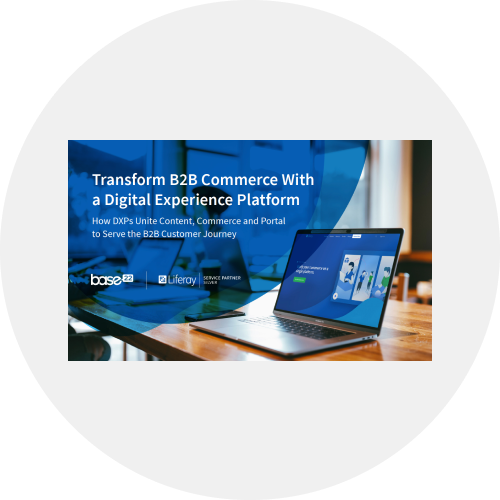With longer sales cycles, hundreds of SKUs with subtle differences, heterogeneous systems, multiple actors, and dynamic purchasing orders, the digital B2B arena is a complex scenario with high risks. Often, B2B companies struggle with technical requirements and entangled processes when interacting digitally with another business. However, being a company with a B2B business model also has its unique opportunities and value. And there’s no digital solution better positioned to address these challenges than B2B portals.
B2B portals are the perfect example of marrying business goals with modern functionality while meeting complex digital requirements from increasingly demanding audiences. They embody Digital Transformation: aligning business and technology toward results and not just acquiring features or functionality without a specific purpose.
In this article, we will cover the following topics:
- An overview of B2B portals
- What types of B2B portals exist:
- Key to success when implementing them
In addition, we will provide some case studies for you to grasp their actual impact on business growth and productivity quickly.
First things first: Defining B2B Portals
B2B portals are digital solutions platforms that allow businesses to interact with each other in a digital ecosystem. They facilitate the exchange of services, products, and information, thereby enhancing the efficiency and effectiveness of business operations.
So, how are B2B portals commonly used? As digital channels, they can
- drive sales and B2B Commerce with transactions and automated workflows
- improve communication and collaboration with interactive features and functionality
- deliver modern and personalized experiences to increase customer loyalty
- create a centralized, secure space for knowledge management
- provide tools and automated processes to boost productivity
One of the most valuable aspects of a B2B portal is providing features, functionality, and a secure space for the many actors around a business-to-business model: managing relationships and interacting with suppliers, partners, dealers, customers, and more. Because the B2B Customer Journey is complex, standard platforms or communication channels may fall short to your needs.
Types of B2B Portals
1. Business and Corporate Portals
Target audience: B2B buyers, customers, partners, or suppliers
Primary objective: Sales and B2B Commerce
Corporate portals serve as a single point of access for all corporate information and applications. They enhance internal communication, collaboration, and knowledge sharing.
With features like personalized content, search capabilities, and integration with other business applications, corporate portals facilitate efficient information management within an organization.
Some of the features of corporate portals:
- managing corporate information and processes,
- managing frequently asked questions, policies, and procedures,
- onboarding processes and training,
- managing sales enablement resources,
- translation and automated workflows.
Some corporate portals have an authenticated space for collaboration and an external public-facing section that is part of a company’s web presence. This type of portal helps with communication, brand presence, collaboration, and engaging potential business with new companies—a critical marketing touchpoint for B2B.
2. B2B Commerce Portals & B2B Customer Portals
Target audience: B2B buyers and B2B customers
Primary objective: Sales and B2B Commerce
Customer portals, also known as B2B Commerce portals or B2B sales portals, are designed to provide business-to-business buyers with a personalized buying experience. These digital solutions support B2B Commerce processes by enabling customers to search for products, place orders, and track deliveries in real-time, plus providing a personalized platform for interaction.
Customer portals may employ eCommerce functionality such as:
- order tracking,
- payment management and check-out processes,
- invoice processing,
- product catalogs,
- product recommendations,
- ERP and CRM integration,
- and purchase history and account management with user authentication.
Per Gartner’s «The Future of B2B Buying» report, the B2B buying journey isn’t linear. It is a back-and-forth process with multiple members of the group and decision-makers that could last months. So, a B2B Commerce portal can provide multiple touchpoints during this journey to improve customer satisfaction and loyalty and build long-term relationships. In addition to this, they provide analytics to understand customers’ needs and preferences better and deliver a seamless and personalized buying experience.

Transform B2B Commerce with a Modern Platform
To stay competitive, companies must move beyond standard Commerce solutions. Learn how a digital platform can support your full B2B customer journey.
Learn more3. Supplier Portals and Procurement Digital Solutions
Target audience: Suppliers, vendors, and businesses that want to interact with you
Primary objective: Procurement and B2B Commerce
Procurement portals, also known as supplier portals, are designed to streamline business procurement processes. These portals enable companies to manage their suppliers from a single touchpoint.
Among its features, supplier portals may include functionality for:
- requesting quotations, bids, or proposals,
- placing orders and payment tracking,
- tracking deliveries in real time,
- managing invoicing and contracts,
- data and systems integration,
- managing campaigns, and
- managing policies and procedures.
Supplier portals help businesses reduce costs, increase efficiency, and improve their relationships with suppliers by providing a central location for all procurement-related activities, thus supporting business continuity. For organizations such as Higher Education institutions and State governments, this solution saves a lot of time and effort by supporting RFPs, bids, and tenders processes.
4. Franchisee Portals
Target audience: Franchisees
Primary objective: Communication and collaboration
Franchisee portals are secure communicational channels that support franchisors and franchisees in managing their operations. This type of B2B portal provides a secure platform for communication, sharing operational guidelines, training materials, marketing resources, and other essential information for the franchisees’ operation.
Some of the features this type of portal may include:
- managing campaigns,
- managing frequently asked questions, policies, and procedures,
- onboarding processes and training,
- managing branding guidelines and media assets,
- managing marketing materials and sales enablement resources,
- interactive feedback components, such as social media-like conversations, surveys, and forms, and
- translation and automated workflows.
The central role of franchisee portals is to facilitate communication between the franchisor and franchisees, from top to bottom, making it easier to monitor performance and address any issues promptly. It is a robust communication and collaboration solution that allows a brand to keep high-quality standards.
5. Distributor and Wholesale Portals
Target audience: Distributors, wholesalers, and B2B brokers or buyers
Primary objective: Sales & B2B Commerce
Distributor and wholesale portals are digital channels that streamline the processes around buying and selling products in bulk. Considering that B2B sellers are now more likely to offer digital channels for Commerce than in-person selling, per McKinsey, this type of B2B portal provides a comprehensive platform for distributors and wholesalers to showcase their products, provide specifications, present their inventory in real time, and manage orders and deliveries.
Distributor portals can have eCommerce components such as:
- order tracking and managing,
- payment management and check-out processes,
- invoice processing,
- product catalogs and product specifications,
- dynamic pricing per region or order size,
- product recommendations,
- and purchase history and account management with user authentication.
Because this type of portal leverages authenticated users, they make recurring orders easier and seamless, with the additional functionality of detailed analytics to help you optimize distribution and wholesale operations.

6. Dealership Portals
Target audience: Dealers
Primary objective: Sales & B2B Commerce
Dealership portals provide a digital platform for manufacturers and dealers to connect, negotiate, and transact. These portals allow manufacturers of vehicles, parts, or industrial equipment to showcase their products, update specifications, and manage orders.
This type of portal aims to enable dealers to promote and offer products when facing directly with their clients.
Because of this, distributor portals can have eCommerce components such as:
- order tracking and managing,
- payment management and check-out processes,
- invoice processing,
- product catalogs and product specifications,
- marketing materials and sales enablement resources,
- dynamic pricing per region or brand,
- product recommendations,
- and purchase history and account management with user authentication.
By facilitating direct communication between manufacturers and dealers, these portals help to streamline distribution and drive business growth.
7. Partner Portals
Target audience: Partners, affiliates, resellers, and more.
Primary objective: Communication and collaboration
A business partner portal is a secure, collaborative platform that enables businesses to manage their partner relationships more efficiently. It provides a centralized access point for customer management, allowing clients to communicate and collaborate with the parent company on critical business functions, including lead generation and management, sales, customer support, partner recruitment, and reporting.
Partner portals offer a self-service model that lets users access the information they need and solve their issues without the assistance of a partner program manager. Their main goal is to facilitate communication and coordination, helping to strengthen the relationship and drive mutual growth. They are typically mobile-responsive and available 24/7, making it easy for partners to access the platform anytime and anywhere.
Some of the features they may include:
- managing campaigns,
- managing frequently asked questions, policies, and procedures,
- managing branding guidelines and media assets,
- interactive feedback components, such as social media-like conversations, surveys, and forms,
- Marketing Development Funds management,
- integrating data and systems,
- deal tracking, and
- support.
A well-designed customer portal can also provide partners with insights into the business and leverage automation to improve operational efficiency, ultimately benefiting all parties involved. According to The State of Partner Ops and Programs by Hubspot, tech stack integration is one of the most pressing challenges for companies with partner enablement programs.
Final Thoughts: The Key to Success with B2B Portals
B2B portals are a powerful tool that can revolutionize the way businesses operate. By providing a digital platform for businesses to interact, transact, and communicate, B2B portals can streamline operations, enhance the buying experience, and drive business growth. Whether you’re a manufacturer, a distributor, a dealer, or a service provider, leveraging a B2B portal is critical to achieving digital success.
There are many ways to start implementing a B2B portal. As portal and platform experts, at Base22, we build, implement, and tailor portals with agility by leveraging a Digital Experience Platform (DXP) and our set of accelerators and tools.
Unlike most B2B best-of-breed technology, B2B portals are pretty flexible. While every company has unique needs, choosing one type of portal over another doesn’t necessarily mean you can’t build or manage more afterward. Multiple solutions or portals can be created and integrated with a single implementation of a Digital Experience Platform.
The key to success lies in understanding what your business comes for and what you want to achieve. No matter how you start or the technique to implement your B2B portal, it is crucial that you partner with an experienced firm such as Base22 that can help you make the most out of your investment and help you drive adoption within your company. Remember: digital solutions are only successful when your workforce truly adopts them.

A Tailored Solution for your Business Model
Our B2B digital solutions meet your business outcomes & tech requirements.
Learn more





